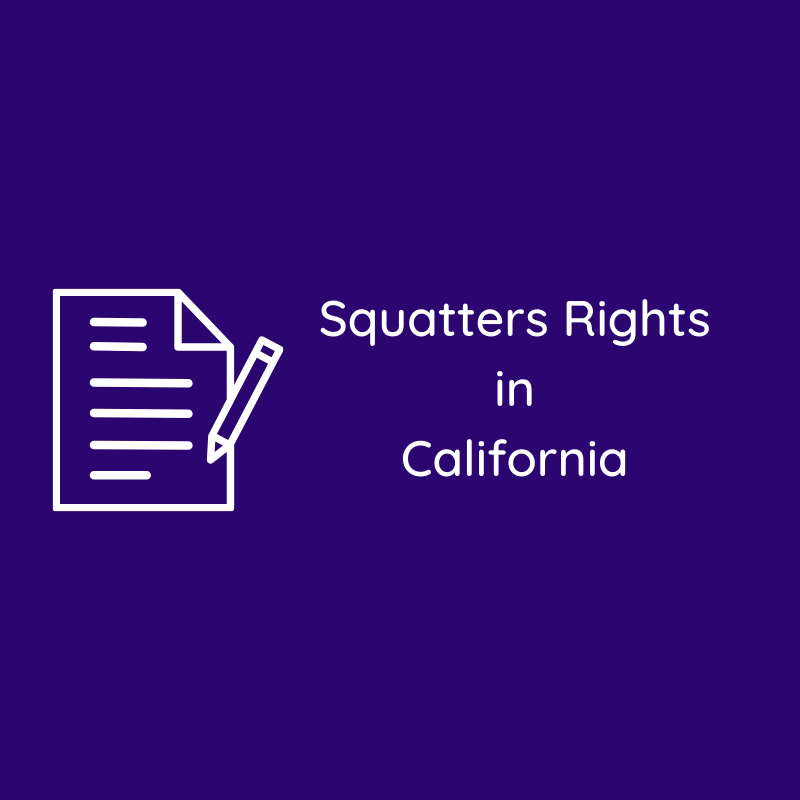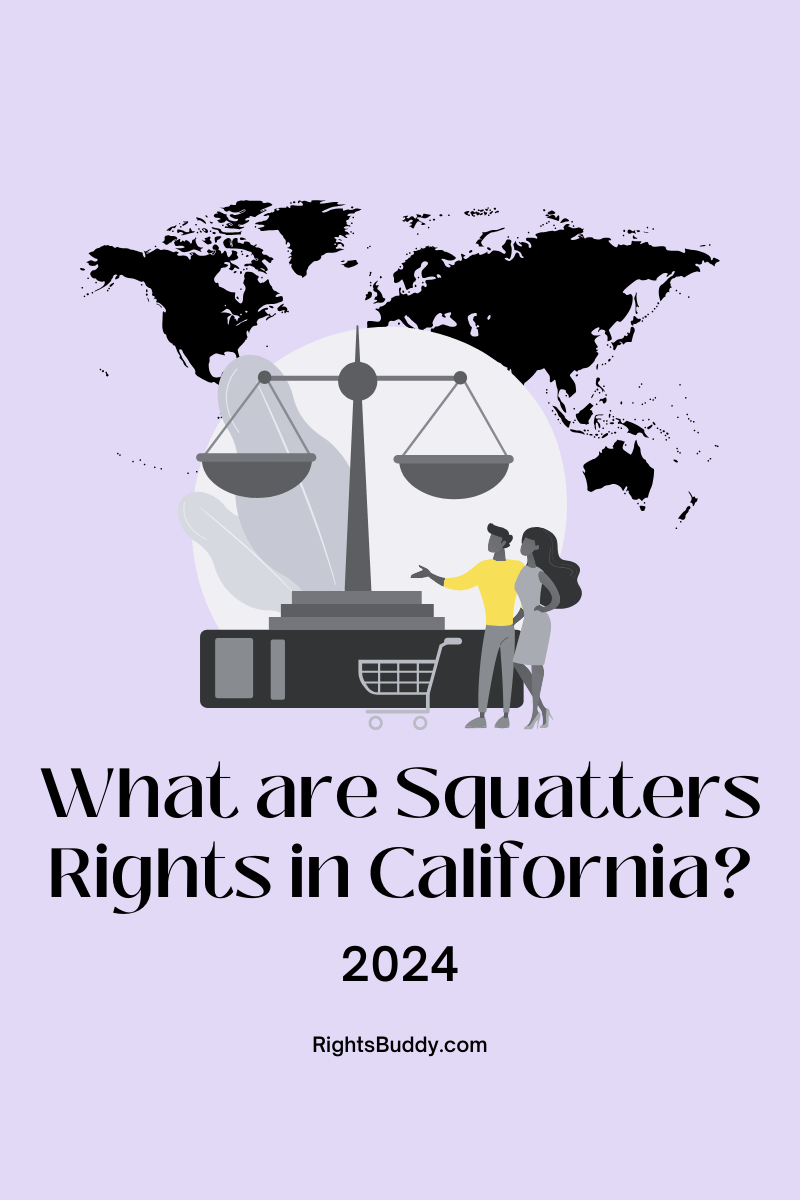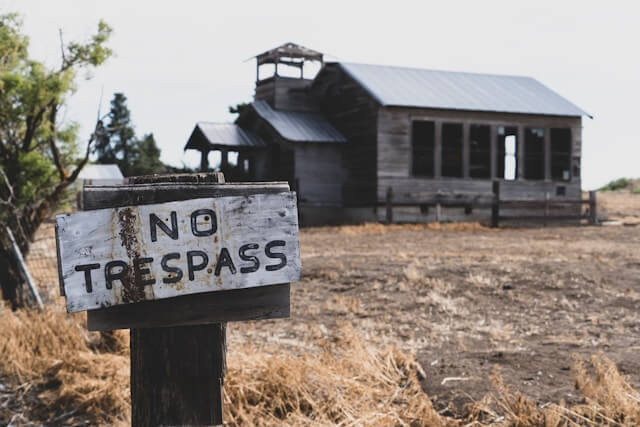Squatters Rights California – Everything you need to know!

Are you a property owner and wondering about squatters rights in California?
In the state of California, the law recognizes the rights of squatters through adverse possession, which allows a person to gain legal ownership of a property through occupation, under certain conditions.
Although the rights of squatters are limited, it is important to understand the legal implications and steps that can be taken to protect your property.
To avoid the headache of dealing with squatters in California, there are a few precautions you can take.
Regularly check on your vacant properties to ensure they are secure and not being occupied by unauthorized individuals.
It is also important to maintain a clear record of property ownership and be proactive about addressing any potential signs of squatting.

In this article, we will dive deeper into the topic of squatters rights in California, providing valuable tips on how to prevent and address squatting on your property.
We will discuss adverse possession claims, how to legally get rid of squatters, and offer practical advice for property owners looking to protect their rights and assets.
Stay tuned for expert insights and guidance on navigating the complexities of squatter laws in California.
What are Squatters Rights in California?

In California, squatters’ rights refer to the legal principle of adverse possession, which allows individuals to gain ownership of a property through continuous and open occupation.
However, this does not apply to properties with a valid title and owner, and certain conditions must be met for squatters to make a claim.
Conditions for Adverse Possession in California
For squatters to establish adverse possession in California, they must demonstrate exclusive and uninterrupted use of the property for a specified period, typically five years. Additionally, the occupation must be open and notorious, meaning it is visible and not concealed from the true owner.
Legal Implications for Property Owners
Property owners in California should be aware of the potential risks associated with squatters’ rights, as failure to take action against unauthorized occupants can result in loss of property rights.
It is essential for owners to monitor their properties regularly and take prompt legal action if squatters are discovered.
But some people confuse squatting with trespassing.
Squatting vs. Trespassing in California
Squatting is the act of unlawfully occupying an uninhabited building or unused land without the owner’s permission.
While Trespassing, on the other hand, is entering someone else’s property without authorization or staying on the property after being asked to leave.
Difference between Squatting and Trespassing
The key difference between squatting and trespassing is that squatting involves taking up residence on the property, while trespassing may involve unauthorized entry or remaining on the property without permission but not necessarily living there.
Penalties for Squatting and Trespassing in California
In California, squatting is considered a criminal offense and can result in both misdemeanor and felony charges. The penalties for squatting may include fines, imprisonment, and restitution to the property owner for any damages.
Trespassing, on the other hand, is typically charged as a misdemeanor in California, with penalties that may include fines, community service, or a short jail term.
How Do Squatters Claim Adverse Possession in California
Adverse possession is a legal doctrine that allows individuals to gain ownership of land they do not have legal title to by occupying it openly, notoriously, and continuously for a specified period of time.
In California, squatters can claim adverse possession by meeting specific legal requirements.
Requirements for Adverse Possession in California
To successfully claim adverse possession in California, squatters must demonstrate that their possession of the property was hostile, actual, open, notorious, exclusive, continuous, and uninterrupted for a period of at least five years.
Hostile possession refers to occupying the land without the owner’s permission, while actual possession entails using the land as the true owner would.
Open and notorious possession means the occupation is obvious and easily observable, exclusionary possession means the squatter is the sole occupant, and continuous possession means the occupation is ongoing without significant breaks.
Proving Adverse Possession
To prove adverse possession, squatters must provide evidence such as property tax payments, maintenance and improvements made to the property, and witness testimony confirming their continuous occupation of the land.
And, they must file a lawsuit to quiet title in court to legally claim ownership of the property.
By meeting these stringent legal requirements, squatters can potentially acquire property through adverse possession in California.
It is crucial for property owners to monitor their land and take legal action to prevent adverse possession claims.
Evicting Squatters in California: How to Get Rid of Squatters in California
In California, squatters have certain rights, including the right to due process and the right to a hearing before they can be evicted.
This means that you cannot simply throw squatters out of your property without following the proper legal procedures.
1. Serve a Notice to Quit
The first step in evicting squatters is to serve them with a notice to quit. This notice must be in writing and must state the following:
- The date the squatters must vacate the property
- The reason for the eviction
- The consequences of failing to vacate the property
2. File an Unlawful Detainer Action
If the squatters do not vacate the property after being served with a notice to quit, you can file an unlawful detainer action in court.
This is a civil action that seeks to recover possession of the property from the squatters.
3. Obtain a Writ of Possession
If you are successful in your unlawful detainer action, the court will issue a writ of possession. This writ orders the sheriff to remove the squatters from the property.
4. Enforce the Writ of Possession
The sheriff will then enforce the writ of possession by removing the squatters from the property. This may involve using force, so it is important to be prepared for this possibility.
Evicting squatters can be a complex and time-consuming process. However, by following the proper legal procedures, you can increase your chances of success.
If you are dealing with squatters on your property in California, it is important to seek legal advice as soon as possible.
How to Protect Your Property from Squatters in California
Here is the step by step process to protect your property from squatters in California:
1. Secure Your Property
The first step in protecting your property from squatters is to make it as difficult as possible for them to enter.
This means securing all doors and windows with sturdy locks and installing security cameras and motion sensor lights.
You should also trim any trees or shrubs that could provide cover for squatters to hide behind. These actions signal that the property is cared for and supervised.
2. Keep an Eye on Your Property
One of the best ways to deter squatters is to keep an eye on your property regularly.
This means inspecting the property for any signs of unauthorized activity, such as broken locks, forced entry, or the presence of unfamiliar people or vehicles.
If you see anything suspicious, you should contact the police immediately.
3. Post No Trespassing Signs

Posting no trespassing signs around your property is another effective way to deter squatters.
These signs should be placed in conspicuous locations, such as near the entrance to the property and along the property line.
The signs should be clear and easy to read, and they should state that trespassing is prohibited and that violators will be prosecuted.
4. Maintain a Presence on the Property:
Having the property actively occupied is one of the most reliable methods to prevent squatting. Whenever feasible, owners should strive to maintain a presence on the property, either by residing there themselves or by finding tenants.
Renting out the property not only provides an additional income stream but also ensures regular activity and monitoring, which significantly reduces the likelihood of squatters.
If personal or rental occupation is not possible, owners might consider hiring a property caretaker or arranging for frequent visits by friends or a property management company.
5. Neighborhood Watch:
Creating a community-centric approach can substantially enhance the property’s security.
Engaging with the local neighborhood watch program or even forming one if it does not exist can be highly beneficial. Inform your neighbors about the vacancy and potential risks so they can be vigilant.
Neighbors can act as additional eyes, noting any unusual activities or presence around the property.
Encourage them to promptly report any anomalies to you or the local authorities. A cohesive community can serve as a critical barrier to squatting.
6. Maintain the Property Properly:

Regular upkeep and maintenance are pivotal in giving off the impression that a property is continually under surveillance and management.
This includes periodic landscaping, mowing lawns, clearing trash, and fixing any external damage or graffiti promptly.
An unkempt property might suggest abandonment or lack of attention, making it a more attractive target for squatters.
Scheduled professional maintenance services could also be a deterrent as the activity and presence of workers will signal that the property is not abandoned.
7. Install Security Systems:

Invest in a good quality security system, which should encompass intrusion alarms alerting authorities in case of a break-in, as well as surveillance cameras capable of recording high-resolution footage at all times.
Ensure these systems are visible to serve as a clear warning to potential squatters that their unauthorized entry or activities will be monitored and recorded.
Signs that announce the presence of surveillance should be posted for added deterrent effect. Digital security solutions with remote monitoring capabilities allow property owners to keep an eye on the property from anywhere in the world.
8. Do Proper Fencing:
A physical barrier, such as a fence or a wall, significantly decreases the accessibility of a property.
High-quality fencing, possibly with added security features such as barbed wire or anti-climb spikes (subject to local regulations), acts as both a physical and psychological deterrent to trespassers.
Ensure all gates have secure locks and are kept closed when the property is unattended.
9. Get Property Insurance:
Property insurance tailored to cover incidents related to squatting could alleviate financial stress in the case of damage or legal confrontations.
Review your policy to ensure it covers issues like vandalism, theft, and legal costs associated with evicting squatters.
In some instances, special riders or endorsements may be necessary to provide comprehensive protection.
Regularly update your insurance company with the status of the property, especially if it becomes vacant, to ensure that your coverage remains in effect and is fully operational in case of an incident involving squatters.
Having a robust insurance plan is an essential safety net for property owners facing the risks associated with unoccupied properties.
10. Take Legal Action if Necessary:
If you discover that squatters have taken possession of your property, you should take legal action to remove them as soon as possible.
This means filing a complaint with the court and obtaining a writ of possession. The writ of possession will order the squatters to vacate the property immediately.
If the squatters refuse to leave, the sheriff will forcibly remove them.
How Much Does it Cost to Evict a Squatter in California
The cost of evicting a squatter in California can vary depending on several factors, including the area in which the property is located, the length of time the squatter has been in possession, and whether or not the squatter is willing to leave voluntarily.
The total cost to Evict a Squatter in California can range from $500 to $10,000. Let’s break it down:
| Action | Approximate Cost |
| Filing Fees (varies by location) | $250 – $450 |
| Serving Notice (varies by method) | $50 – $150 |
| Attorney Fees (optional, highly recommended) | $1,500 – $5,000+ |
| Lost Rent | Varies depending on the duration of squatter occupancy |
| Potential Damages | Varies depending on the damage caused by the squatter |
| Court Hearing Fees (if necessary) | $50 – $100 |
Legal Fees
The most significant expense associated with evicting a squatter is typically legal fees.
Landlords will need to hire an attorney to file a complaint with the court and represent them throughout the eviction process.
The cost of legal fees can vary depending on the complexity of the case and the experience of the attorney.
Landlords should expect to pay at least $1,000-$1500 in legal fees, and the total cost could be significantly higher if the case goes to trial.
Court Costs
In addition to legal fees, landlords will also need to pay court costs. These costs can vary depending on the county in which the property is located.
However, landlords should expect to pay $50-$100 in court costs. These costs may include filing fees, process server fees, and jury fees.
Other Expenses
In some cases, landlords may also incur other expenses associated with evicting a squatter.
These expenses could include the cost of hiring a locksmith to change the locks on the property, the cost of cleaning up the property after the squatter has been evicted, and the cost of storing the squatter’s belongings.
The total cost of these expenses can vary depending on the specific circumstances of the case.
How To Claim Squatters Rights In California
To successfully claim squatters’ rights in California, you must meet specific legal requirements known as adverse possession.
1. Requirements:
These requirements include:
1. Open and notorious possession:
You must possess the property openly and notoriously, meaning your possession is visible and apparent to others.
2. Exclusive possession:
You must have exclusive possession of the property, meaning you are the only person using and occupying it.
3. Continuous possession:
You must possess the property continuously for a specified period, which is typically five years in California.
4. Hostile possession:
Your possession must be hostile, meaning you must possess the property without the owner’s permission or consent.
5. Payment of property taxes:
You must pay all property taxes and assessments levied against the property during the adverse possession period.
2. Find an Abandoned or Vacant Property:
Locate an abandoned or vacant property that you believe meets the requirements for adverse possession.
Look for properties with no visible signs of ownership or maintenance, such as overgrown vegetation, broken windows, or dilapidated structures.
3. Take Possession of the Property:
Once you have identified a suitable property, begin taking possession of it. This involves moving onto the property, making repairs and improvements, and using it as your own.
Ensure your possession is open, notorious, exclusive, and continuous.
4. Maintain the Property and Pay Taxes:
During the adverse possession period, you must maintain the property and pay all property taxes and assessments levied against it.
This demonstrates your intent to possess the property as an owner and not merely as a trespasser.
5. File a Quiet Title Action:
After meeting the adverse possession requirements, you can file a quiet title action in the California Superior Court.
This legal action allows you to establish your ownership rights to the property and remove any clouds on the title.
The court will review your evidence and determine if you have successfully acquired title to the property through adverse possession.
Remember, claiming squatters’ rights is a complex legal process with specific requirements and potential legal challenges. It’s advisable to consult with an experienced real estate attorney to ensure you understand the process and your rights before proceeding.
FAQs about Squatters Right in California
Here are some of the most asked questions.
1. How long does it take to establish squatters’ rights in California?
The time required to establish squatters’ rights in California is five years. However, this period may be shorter if the squatter can prove that they have made substantial improvements to the property.
2. What are the defenses to a claim of squatters’ rights in California?
There are several defenses that a property owner can assert to a claim of squatters’ rights in California, including:
- The owner’s actual possession of the property.
- The owner’s constructive possession of the property.
- The owner’s payment of property taxes on the property.
- The owner’s lack of knowledge of the squatter’s possession.
- The squatter’s failure to meet the requirements for adverse possession.
3. What are the consequences of establishing squatters’ rights in California?
If a squatter successfully establishes squatters’ rights in California, they will become the legal owner of the property.
The former owner will lose all rights to the property, including the right to possession, the right to use the property, and the right to sell the property.
Conclusion: Squatters Right in California
We have discussed in detail the concept of squatting laws in California and whether squatters have rights in the state.
We have also provided some valuable tips on how to avoid squatters from taking over your property. Additionally, we have shared insights into squatters’ rights, adverse possession claims, and the legal process involved in removing squatters from your property.
It is important to remember that squatting laws vary from state to state, and it is crucial to consult with a legal professional or refer to the California Civil Code for specific guidance on your situation.
By understanding your rights and taking proactive measures, you can protect your property from squatters and maintain its value.
If you find yourself dealing with a squatter situation, it is essential to act promptly and seek legal advice.
Attempting to remove squatters on your own can be dangerous and may lead to legal complications.
By working with an attorney and following the proper legal procedures, you can effectively resolve the issue and regain possession of your property.
I hope you liked this article. Let me know in the comments.
Hi! I want to say that this post is awesome, nice written and come with approximately all significant infos. I would like to peer extra posts like this.